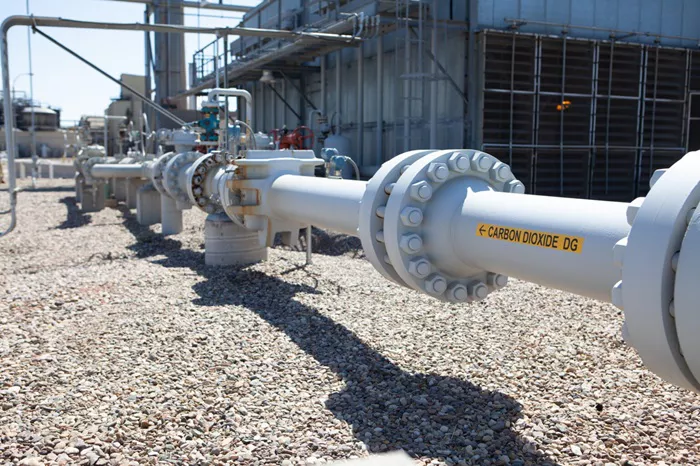In recent years, major oil companies have been heavily investing in carbon capture and storage (CCS) technology, claiming it helps offset CO2 emissions from their energy products. Environmentalists have largely dismissed these efforts as greenwashing, cautioning that CCS technology is not yet proven on the scale needed for significant decarbonization. New research, however, suggests that these environmentalists may have a point, revealing that carbon capture can significantly extend the productivity of near-depleted oilfields.
A study conducted by Menhwei Zhao, a senior geological advisor based in Calgary, and published in the AAPG Bulletin, examined over 22 years of production data from the Weyburn Midale oil pool in Saskatchewan. This oil pool has been receiving CO2 injections since 2000, making it the world’s longest-running Enhanced Oil Recovery (EOR) project. Zhao concluded that without CO2 injection, the pool would have ceased oil production by 2016. However, the use of CO2 for enhanced oil recovery could extend the pool’s lifespan by another 39 to 84 years. Zhao noted that while his study focused on a specific project in Canada, he expects similar outcomes for large-scale CCS projects globally.
Supporting Zhao’s findings, the Wasson Field’s Denver Unit CO2 EOR project saw a nearly seven-fold increase in crude production after CO2 injection.
These findings come as the Canadian and Alberta governments are committing over $15.3 billion in tax credits for CCS projects targeting the country’s largest oil sands producers. Similarly, the U.K. government has pledged £20 billion in CCS subsidies, and U.S. oil and gas producers can access a tax credit of $85 per ton of carbon dioxide sequestered in geological formations, or $60 per ton if used for EOR.
In a significant move last year, Exxon Mobil acquired Denbury Inc., a developer of CCS solutions, in an all-stock transaction valued at $4.9 billion. Denbury uses recycled CO2 in its EOR operations to produce carbon-negative Blue Oil. Now an Exxon subsidiary, Denbury owns the largest CO2 pipeline network in the U.S., spanning 1,300 miles, including nearly 925 miles in Louisiana, Texas, and Mississippi, along with 10 onshore sequestration sites. Additionally, Exxon Mobil signed a long-term contract with industrial gas company Linde Plc. to transport and permanently store up to 2.2 million metric tons of CO2 annually from Linde’s planned clean hydrogen project in Beaumont, Texas.
Exxon’s peer, Schlumberger Ltd., has also entered the CCS arena, establishing the SLB New Energy unit to invest in five niche segments, including CCS. According to Gavin Rennick, president of SLB New Energy, each segment has a minimum addressable market of $10 billion per year.
CCS for Enhanced Oil Recovery
Crude oil production in U.S. oil fields typically involves three phases: primary, secondary, and tertiary (enhanced) recovery. Primary recovery relies on gravity, natural reservoir pressure, and artificial lift techniques, recovering about 10 percent of a reservoir’s original oil in place (OOIP). Secondary recovery extends a field’s productive life by injecting water or gas to displace oil, typically recovering 20 to 40 percent of OOIP.
As easily accessible oil has been largely depleted, producers have turned to tertiary or enhanced oil recovery (EOR) techniques, which can recover 30 to 60 percent or more of a reservoir’s OOIP. The three major categories of EOR are gas injection, chemical injection, and thermal recovery. Gas injection, the most common EOR technology in the U.S., uses gases like CO2, natural gas, or nitrogen to expand in the reservoir, pushing additional oil to a production wellbore and dissolving in the oil to lower its viscosity and improve flow rate. CO2 injection has been successfully implemented across various U.S. states, including Texas, New Mexico, Kansas, Mississippi, and more.
The U.S. Department of Energy (DoE) is researching innovative techniques to enhance the economic performance and applicability of CO2 injection. The DoE estimates that next-generation CO2-EOR could potentially produce over 60 billion barrels of oil that would otherwise remain trapped in the rock.
In summary, while CCS technology’s role in large-scale decarbonization remains debated, its ability to extend the life of oilfields through enhanced oil recovery presents a significant, if contentious, benefit to the oil industry.
Related topics:
Putin Extends Measures Western Oil Price Cap Until End of 2024
Crude Oil Prices Decline Amid Demand Cuts and Supply Glut Projections

